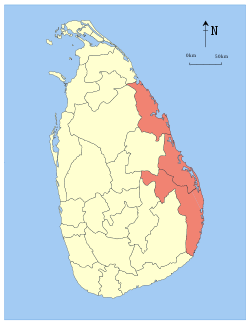1987 Eastern Province massacres
The 1987 Eastern Province massacres were a series of massacres of the Sinhalese population in the Eastern Province of Sri Lanka during the Sri Lankan Civil War. Though they began spontaneously, they became more organized, with the LTTE leading the violence.[1]
| 1987 Eastern Province massacres | |
|---|---|
 | |
| Location | Eastern Province, Sri Lanka, Sri Lanka |
| Coordinates | 8°35′N 81°13′E |
| Date | 29 September 1987– 8 October 1987 |
| Target | Primarily Sinhalese civilians |
| Deaths | 200+ |
| Perpetrators | Rioters, Indian Peacekeeping Force, Tamil Eelam Liberation Organization |
Background
The Eastern province was a highly contested zone between the Sinhalese and Tamils. Since the 1930's, the majority Sinhalese government settled Sinhalese in the Eastern province with the explicit intention of restoring the historic Sinhalese homeland. Tamil nationalists viewed this as an attempt to alter the demographics of the Tamil homeland, thus weakening the Tamils' stake in it.[2] During the 1983 riots, Trincomalee was the site of anti-Tamil violence at the hands of Sinhalese sailors. With the start of the civil war, in 1985, many residents of the Trincomalee District were expelled by the Sri Lankan Army to make way for Sinhalese settlers, with help from the settlers themselves at times.[3]
In late September 1987, Thileepan began a hunger strike. On the 21st of September, a scuffle broke out between a Tamil gang who gathered in support of Thileepan and Sinhalese group at the Anuradhapura Junction in Trincomalee. Ethnic violence had begun where the Sinhalese and Tamils were both perpetrators and victims. On September 24, Sinhalese from Mihindupura had left in bullock carts; the next morning, the carts returned without them and 9 charred bodies were found with a burnt cart. The LTTE was suspected to have perpetrated the killings.[4] Thileepan eventually died from his hunger strike, inviting grief from the Tamil community. Around the same time, the IPKF had nominated members for the Interim Council of the North and East, a majority of them being LTTE representatives.
Incident
Trincomalee riots
After the Interim Council was announced to be mostly LTTE nominees, anti-Sinhalese violence flared in Trincomalee, an ethnically heterogeneous city, on September 29. On September 30, 2 Tamils were found hacked to death; in retaliation, a Tamil group killed 3 Sinhalese men in a truck.[4] The violence became more organized on October 1, with LTTE members leading rioters and warning Sinhalese to evacuate their homes lest they be killed. In Trincomalee and throughout the Eastern Province, properties were set on fire, and over 2,000 people, mostly Sinhalese, were rendered homeless.[1][4] Tamil rioters, with the help of militant leaders, brutally killed Sinhalese men. Around 50 Sinhalese who were well established in the community had been killed in the area of the main Sinhalese school. Corpses were thrown into wells that were covered up.[5] The IPKF prevented any intervention by the Sri Lankan Army. They fired at a crowd of Sinhalese gathered at the King's Hotel Junction, killing one. At J. R. Jayawardene's request, the IPKF had 11 platoons come into Trincomalee to restore order. On October 4, the IPKF shot a Sinhalese Buddhist monk who had demonstrated against them.[4]
Militant action
Following the suicide of the Palaly prisoners on October 5, Tamil militant violence spread throughout the Eastern Province. In Batticaloa, Sinhalese who had long coexisted amicably with Tamils had been attacked, even upsetting some LTTE leaders.[6] Sinhalese and Muslims were massacred in buses, trains, and villages in various regions in the Eastern province.[7][8][9] By the end of the violence, over 200 Sinhalese civilians were estimated to be dead, and 20,000 were made refugees.[1]
References
- Rubin, Barnett (1987). Cycles of Violence: Human Rights in Sri Lanka Since the Indo-Sri Lanka Agreement. Human Rights Watch. ISBN 9780938579434. Retrieved 8 December 2018.
- Peebles, Patrick (February 1990). "Colonization and Ethnic Conflict in the Dry Zone of Sri Lanka". The Journal of Asian Studies. 49 (1): 30–55. doi:10.2307/2058432. JSTOR 2058432.
- "Can the East be won through Human Culling?". uthr.org. University Teacher of Human Rights - Jaffna. Retrieved 11 December 2018.
- Hoole, Rajan (July 2001). Sri Lanka: The Arrogance of Power: Myths, Decadence & Murder (1st ed.). University Teachers for Human Rights (Jaffna). p. 226. ISBN 9559447041.
- "Trincomalee: State Ideology and the Politics of Fear". University Teachers for Human Rights (Jaffna). Retrieved 27 March 2019.
- "Human rights and The Issues of War and Peace". uthr.org. University Teacher for Human Rights Jaffna. Retrieved 10 December 2018.
- Cruez, Patrick (October 7, 1987). "Rebels Kill 140 Sinhalese in Six Attacks". AP News. Retrieved 11 May 2019.
- Weintraub, Richard (October 7, 1987). "Tamils Kill Dozens in Revenge". Washington Post. Retrieved 11 May 2019.
- Weisman, Steven (October 8, 1987). "160 Die in Sri Lanka; India Vows to Curb Attacks". The New York Times. Retrieved 11 May 2019.